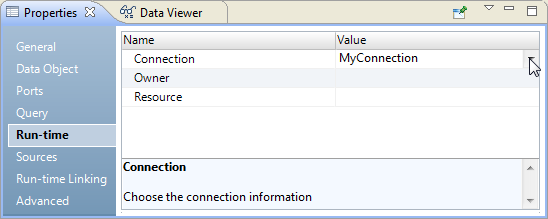Read Transformation Properties
After you create a Read transformation, you can configure properties for the transformation.
Configure Read transformation properties on property tabs. The tabs you can use depend on the type of source that the Read transformation represents.
The following table describes each property tab and identifies the source type you use the tab for:
Property Tab | Description | Source Type |
|---|
General | Specify transformation properties and behavior. For relational and customized data object sources, synchronize transformation input ports with source. | All |
Data Object | Specify the transformation data source. | - - Relational
- - Flat file
- - Customized data object
|
Ports | Set port definition by the associated data object. | - - Relational
- - Customized data object
- - Logical data object
|
Format | Input settings for a flat file data source | Flat file |
Query | Specify a query to the source. | - - Relational
- - Customized data object
- - Logical data object
|
Run-time | Define run-time behavior. | - - Relational
- - Flat file
- - Customized data object
|
Sources | Select source tables and configure source details. | - - Relational
- - Customized data object
|
Data Object Parameters | Set parameter properties. | - - Flat file
- - Customized data object
- - Logical data object
|
Run Time Linking | Configure a group-to-group link between transformations that uses a parameter, a link policy, or both to determine which ports to link at run time. | All |
Advanced | Set tracing level and row order. For a relational source, set option to create or replace the target table at run time. | All |
General Properties
You can configure the name and description of the Read transformation. You can also configure the following properties:
- When Column Metadata Changes
- Available for relational sources. Select one of the following options:
- - Synchronize output ports. The Developer tool updates Read transformation output ports with metadata changes that the Model repository stores for the data object.
- - Do not synchronize. The Read transformation does not show metadata changes in the data object.
- Physical Data Object
- Available for flat file and customized sources. The object used to create the transformation.
- You can select the data object name and configure its properties.
Data Object Properties
On the Data Object tab, you can specify or change the Read transformation source, and make relational, flat file, and customized data object sources dynamic.
You can configure the following properties:
- Specify By
- To specify source columns and metadata for the Read transformation, select one of the following options:
- - Value. The Read transformation uses the associated data object to specify source columns and metadata.
- - Parameter. The Read transformation uses a parameter to specify source columns and metadata.
- Data Object
- If you created the Read transformation from an existing data object, the field displays the name of the object. Click Browse to change the data object to associate with the Read transformation.
- At runtime, get data object columns from data source
- When you enable this option, the Data Integration Service fetches metadata and data definition changes from source tables to the Read transformation.
Query Properties
Configure an SQL query to a relational resource or customized data object.
When you configure properties on the Query tab, you choose to configure simple or advanced properties.
In the Simple properties view, you configure the default SQL statement as a Define Distinct statement, and to edit the hints, join, filter and sort conditions for the statement.
In the Advanced properties view, you can define a custom SQL query. You can select from columns in the associated data object, or from parameters, or create a new parameter to represent a data object.
Run-Time Properties
You can configure the following Read transformation properties on the Run-time tab:
- Connection
- Available for relational sources. Connection used by the transformation. Click in the right side of the field to change the connection.
- The following image shows the location of the dropdown button to click:
Sources Properties
Configure the details of sources for relational resources and customized data objects. You can change the relational data object definition after you import it to the repository. You can add and remove ports, define primary keys, and configure relationships between multiple relational data objects in the repository.
The Sources tab enables you to configure the following settings:
- All sources
- Use the Add and Remove buttons to add and remove additional sources for the transformation.
- General tab
- Change the name and description for the selected source. Click the source name to change other details.
- Keys tab
- Designate resource columns as keys.
- Relationships tab
- Add and remove relationships between multiple relational resources.
Advanced Properties
Configure advanced properties to determine how the Data Integration Service processes data for the Read transformation.
Configure the following properties on the Advanced tab:
- Tracing level
- Control the amount of detail in the mapping log file.
- PreSQL
- SQL command the Data Integration Service runs against the source database before it reads the source.
- The Developer tool does not validate the SQL.
- PostSQL
- SQL command that the Data Integration Service runs against the source database after it writes to the target.
- The Developer tool does not validate the SQL.
- Constraints
- SQL statements for table-level referential integrity constraints. Applies to relational sources only.

